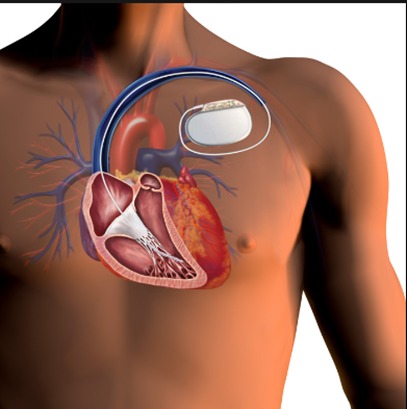ICD
ICD stands for Implantable Cardioverter Defibrillator. It’s a small device implanted in the chest or abdomen of patients who are at risk of sudden cardiac death due to life-threatening arrhythmias, particularly ventricular tachycardia (VT) or ventricular fibrillation (VF). Here’s how it works and its main components:
- Functionality: An ICD continuously monitors the heart’s rhythm. If it detects a dangerous arrhythmia, it delivers a precisely calibrated electrical shock to restore the heart’s normal rhythm. This shock is known as defibrillation. In addition to defibrillation, many modern ICDs also have pacing capabilities, which allow them to deliver small electrical impulses to regulate the heart rate if it becomes too slow (bradycardia).
- Implantation: Implanting an ICD is a minimally invasive surgical procedure typically performed under local anesthesia. The device is placed under the skin, usually just below the collarbone. One or more leads (thin, insulated wires) are threaded through blood vessels into the heart’s chambers. These leads detect the heart’s electrical activity and deliver therapy as needed.
- Components: The main components of an ICD include:
- Generator: The generator is the main component of the device and contains the battery and electronic circuitry. It’s responsible for monitoring the heart’s rhythm and delivering therapy when necessary.
- Leads: Leads are thin, insulated wires that carry electrical signals between the heart and the ICD. They are implanted into the heart’s chambers and can sense abnormal rhythms as well as deliver electrical shocks or pacing impulses.
- Battery: The battery provides power to the device and typically lasts for several years. When the battery nears the end of its life, the entire device may need to be replaced through a minor surgical procedure.
- Programming Unit: Physicians use a programming unit to adjust the device’s settings, such as the threshold for delivering therapy and the type of therapy delivered.
- Indications: ICDs are indicated for patients who are at high risk of sudden cardiac death due to certain conditions, such as:
- Prior history of VT or VF
- Previous heart attack (myocardial infarction) with reduced ejection fraction
- Certain genetic conditions predisposing to arrhythmias
- Heart failure with reduced ejection fraction despite optimal medical therapy
- Long QT syndrome or other inherited arrhythmia syndromes
ICDs have been shown to significantly reduce the risk of sudden cardiac death and improve survival in high-risk patients. However, they also carry some risks, including complications related to implantation and inappropriate shocks due to device malfunction or misinterpretation of heart rhythms. Therefore, careful patient selection and ongoing monitoring are essential for the safe and effective use of ICDs.
